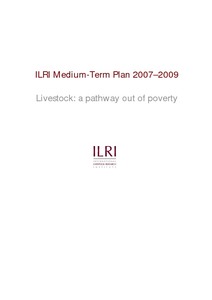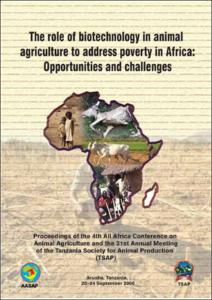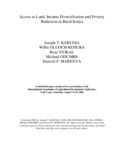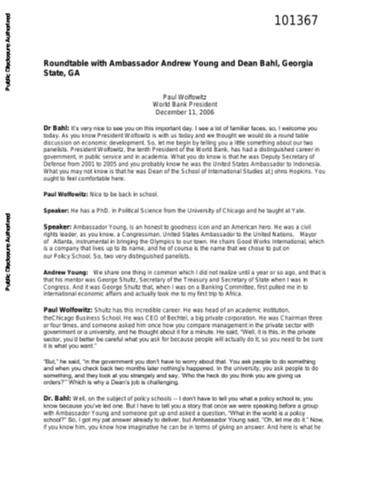Pastoralists preferences for cattle traits: Letting them be heard
This paper investigates preferences for cattle traits among a pastoral community in a trypanosomosis prevalent area in Kenya. Choice experiments and mixed logit models are employed to estimate economic values of preferred traits which could be introduced through systematic breeding in breed improvement programs that utilise trypanotolerance trait. The findings suggest preference for traits linked to drought tolerance, high live weight, trypanotolerance and fecundity.
The role of biotechnology in animal agriculture to address poverty in Africa: opportunities and challenges
The role of district government in poverty alleviation: case studies in Malinau and West Kutai Districts, East Kalimantan, Indonesia
Where are the poor and where are the trees?: targeting of poverty reduction and forest conservation in Vietnam
This paper highlights the spatial linkages of forest quality with poverty incidence and poverty density in Vietnam. Most of the Vietnamese poor live in densely populated river deltas and cities while remote upland areas have the highest poverty incidences, gaps, and severities. Forests of high local and global value are located in areas where relatively few poor people live, but where the incidence, gap, and severity of poverty are strongest, and where the livelihood strategies are based on agricultural and forest activities.
Where are the poor and where are the trees?: targeting of poverty reduction and forest conservation in Vietnam (Vietnamese)
This paper highlights the spatial linkages of forest quality with poverty incidence and poverty density in Vietnam. Most of the Vietnamese poor live in densely populated river deltas and cities while remote upland areas have the highest poverty incidences, gaps, and severities. Forests of high local and global value are located in areas where relatively few poor people live, but where the incidence, gap, and severity of poverty are strongest, and where the livelihood strategies are based on agricultural and forest activities.
Crop research to benefit poor farmers in marginal areas of the developing world: a review of technical challenges and tools.CAB Reviews
Despite great successes in crop research for the developing world, many poor farmers in marginal areas have not benefited. There is increasing recognition that crop research can and should benefit these farmers. This paper reviews some of the key technical issues related to the challenge of formulating and carrying out crop research that is targeted, relevant and appropriate to these farmers, with a particular emphasis on crop improvement. It examines the reasons that underpin the lack of research impacts, and some of the key challenges and tools available to make this happen.
Access to Land, Income Diversification and Poverty Reduction in Rural Kenya
he increasing land scarcity and the worsening trend of poverty in Kenya in recent years have raised concerns about the focus on land-based agriculture as the basis of growth in the rural areas. This paper combines two complementary data sets obtained from two locations in Kenya, drawn against distinctively different land availability patterns, to examine the diverse rural asset base and key sources of livelihood in the rural areas.
Land tenure and water rights in Thailand and Vietnam - challenges for ethnic minorities in mountainous forest regions
Ethnic minorities in the mountainous forest regions of northern Thailand and northern Vietnam live in a particularly restrictive political, social and economic environment. Widespread degradation of land, water and forest resources has adverse effects on the livelihoods of these groups. Given the dramatically increasing scarcity of natural resources, regulation of resource access and allocation are becoming fundamental for the development of sustainable resource management, in which an active participation of the local population in planning and implementation is a crucial prerequisite.
Roundtable Discussion on Economic Development, Georgia State, GA, December 11, 2006
Paul Wolfowitz, President of the World Bank, and Ambassador Andrew Young engaged in a roundtable discussion on economic development, moderated by Dean Bahl of Georgia State. Wolfowitz has made Africa the first priority of the Bank. There is really a chance for Africa to turn the corner. It’s going to have to start with the best performers, doing what the so-called Tigers did in East Asia, showing the way for other countries. Young said you can make more money honestly in a growing economy, than you can steal in a dying economy. Wolfowitz gave examples of the turnaround in Africa.
Improving Tenure Security for the Rural Poor. Rwanda – Country Case Study
Most of the world’s poor work in the “informal economy” – outside of recognized and enforceable rules.
Thus, even though most have assets of some kind, they have no way to document their possessions
because they lack formal access to legally recognized tools such as deeds, contracts and permits.
The Commission on Legal Empowerment of the Poor (CLEP) is the first global anti-poverty initiative
focusing on the link between exclusion, poverty and law, looking for practical solutions to the challenges
Poverty Mapping in Uganda: An Analysis Using Remotely Sensed and Other Environmental Data
This is the 36th of a series of Working Papers prepared for the Pro-Poor Livestock Policy Initiative (PPLPI). The purpose of these papers is to explore issues related to livestock development in the context of poverty alleviation. In order to reduce poverty we must first describe, explain and predict its spatial distribution over large areas with as high a level of local accuracy as possible. Poverty maps are traditionally produced by exploiting links between census (wide area) and survey (smaller area coverage) data.








